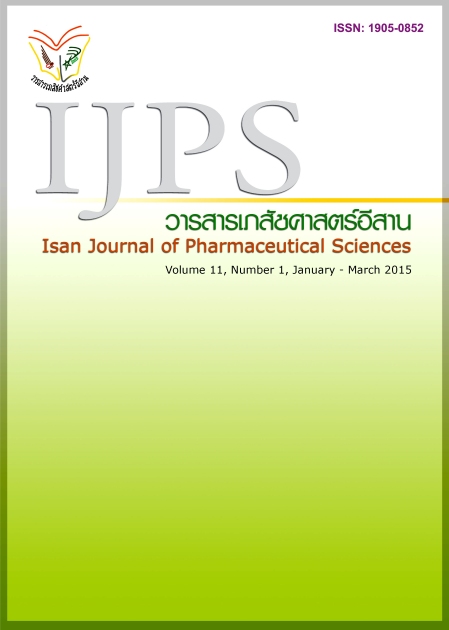Outcome of Disease Management on HbA1C in Type 2 Diabetic Patients Treated with Insulin Injection in Lueamnat Hospital, Amnat Charoen Province
Main Article Content
Abstract
Chronic disease management is an active health service that linked to disease screening. The objectives of this health service are to reduce complications and promote continuing health care. The objectives of this study were: 1) to study HbA1c change in type 2 diabetic patients treated with insulin injection before and after participating in the disease management; 2) to evaluate patient satisfaction on the disease management and 3) to assess health care provider opinion towards the disease management model. Methods: This quasi-experimental study with a pre-test and post-test comparison was performed between October 2013 and March 2014. The multi-disciplinary team developed the model that was modified from chronic care model. The sample was 149 diabetes patients, who were separated into 3 groups, with each receiving the same intervention, but different frequency of activities ;1) 32 patients with HbA1c 7.1-8.0% receiving 1 training and 2 self-help group and 1 home visit 2) 42 patients with HbA1c 8.1-9.0% receiving 1 training and 3 self-help group and 2 times of home visit and 3) 75 patients with HbA1c greater than 9% receiving 1 training and 6 self-help group and 3 home visit. The qualitative data was analyzed by using the content analysis. The quantitative data were analyzed by using descriptive and inferential statistics. Results: The median of HbA1c in the patients group เ, group II and group III before receiving interventions, were 7.60, 8.60 and 10.90% and after the intervention were 7.10, 8.30 and 10.10%, respectively. There was no statistical difference in the median of HbA1c before and after receiving intervention in both in group I (HbA1c 7.1-8.0%) and group III (HbA1c>9.0%). However, group II (HbA1c 8.1-9.0%) showed a statistically significant difference at 0.05 when comparing the result before and after the intervention. All three groups of patients showed higher level of satisfaction of the disease management with the significance at 0.05. Conclusion: The study reveals that the disease management affects the lowering of HbA1c in diabetic patients with HbA1c 8.1-9.0%. The refore, long term monitoring with continuing care is effective.
Article Details
In the case that some parts are used by others The author must Confirm that obtaining permission to use some of the original authors. And must attach evidence That the permission has been included
References
American Diabetes Association. Standards of medical care in diabetes-2010. Diabetes Care [serial online] 2010; 33(1): 11-61.
Boonkhun S. IN HOME SSS [Online] 2010 [cited 2013 July 1]. Available from:https://groups.google.com/forum/#!topic/khuanniangrehab/R3eFwWxlvOE
Bureau of Policy and strategy. Public Health Statistics 2009 [Online] 2009 [cited 20 July 2013] .Available from:URL:https://bps.ops.moph.go.th/index.php?mod+bps&doc=5.
Busarakumvadee N. and Sripunyavuttisuk. Y. The development of a diabetic caring model in Nakhon Nayok Hospital. Journal of Nursing and Education 2012; 5(2): 114-129.
International Diabetes Federation. The Global Burden [serial online] 2011 [cited 2012 July-23] Available from https://www.idf.org/diabetesatlas/global-burden.
Kasamsuk J. Communication and social change. [Online]2011 [cited 17 April 2013]. Available from: https://pknow.edupol.org/course/C2/document/10/10_8.pdf.
Lueamnat Hospital. Results of the inspection in Amnat Charoen Province. [n.p.:n.d.];2012.
Lueamnat Hospital. Results of the supervisory official District 13. [n.p.:n.d.]; 2013.
Mokkaramanee R. Technical Training: Technique. [Online] 2006 [cited 2014 April 16]. Available from: https://www.academia.edu/4373947/.
National Health Security Office, Thailand. National Health Insurance Fund Administration Guide, Volume 4, 2013. [n.p.]; 2012.
Watnasup w. To contribute to the development of the organization. The objective of the dual banking sector employers and employees to resolve labor issues in the organization; 6-8 March 2003.


